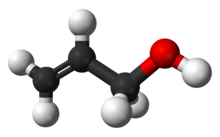Allyl alcohol

| |

| |
| Names | |
|---|---|
| Preferred IUPAC name
Prop-2-en-1-ol | |
| Other names
Allyl alcohol
2-Propen-1-ol 1-Propen-3-ol[1] Vinyl carbinol[1] Allylic alcohol Weed drench[citation needed] | |
| Identifiers | |
3D model (JSmol)
|
|
| 3DMet | |
| ChEBI | |
| ChEMBL | |
| ChemSpider | |
| ECHA InfoCard | 100.003.156 |
| EC Number |
|
| KEGG | |
PubChemCID
|
|
| RTECS number |
|
| UNII | |
| UN number | 1098 |
CompTox Dashboard(EPA)
|
|
| |
| |
| Properties | |
| C3H6O | |
| Molar mass | 58.080g·mol−1 |
| Appearance | colorless liquid[1] |
| Odor | mustard-like[1] |
| Density | 0.854 g/ml |
| Melting point | −129 °C |
| Boiling point | 97 °C (207 °F; 370 K) |
| Miscible | |
| Vapor pressure | 17 mmHg[1] |
| Acidity(pKa) | 15.5 (H2O)[2] |
| -36.70·10−6cm3/mol | |
| Hazards | |
| Occupational safety and health(OHS/OSH): | |
Main hazards
|
Highly toxic, lachrymator |
| GHSlabelling: | |
   
| |
| Danger | |
| H225,H301,H302,H311,H315,H319,H331,H335,H400 | |
| P210,P233,P240,P241,P242,P243,P261,P264,P270,P271,P273,P280,P301+P310,P302+P352,P303+P361+P353,P304+P340,P305+P351+P338,P311,P312,P321,P322,P330,P332+P313,P337+P313,P361,P362,P363,P370+P378,P391,P403+P233,P403+P235,P405,P501 | |
| NFPA 704(fire diamond) | |
| Flash point | 21 °C (70 °F; 294 K) |
| 378 °C (712 °F; 651 K) | |
| Explosive limits | 2.5–18.0% |
| Lethal doseor concentration (LD, LC): | |
LD50(median dose)
|
80 mg/kg (rat, orally)[3] |
LC50(median concentration)
|
1000 ppm (mammal, 1 hr) 76 ppm (rat, 8 hr) 207 ppm (mouse, 2 hr) 1000 ppm (rabbit, 3.5 hr) 1000 ppm (monkey, 4 hr) 1060 ppm (rat, 1 hr) 165 ppm (rat, 4 hr) 76 ppm (rat, 8 hr)[4] |
| NIOSH(US health exposure limits): | |
PEL(Permissible)
|
2 ppm[1] |
REL(Recommended)
|
TWA 2 ppm (5 mg/m3) ST 4 ppm (10 mg/m3) [skin][1] |
IDLH(Immediate danger)
|
20 ppm[1] |
| Safety data sheet(SDS) | External MSDS |
Except where otherwise noted, data are given for materials in theirstandard state(at 25 °C [77 °F], 100 kPa).
| |
Allyl alcohol(IUPAC name:prop-2-en-1-ol) is anorganic compoundwith thestructural formulaCH2=CHCH2OH.Like manyalcohols,it is a water-soluble, colourless liquid. It is more toxic than typical small alcohols. Allyl alcohol is used as aprecursorto many specialized compounds such as flame-resistant materials,drying oils,andplasticizers.[5]Allyl alcohol is the smallest representative of theallylicalcohols.
Production
[edit]Allyl alcohol is produced commercially by theOlinandShellcorporationsthrough the hydrolysis ofallyl chloride:
- CH2=CHCH2Cl + NaOH → CH2=CHCH2OH + NaCl
Allyl alcohol can also be made by the rearrangement ofpropylene oxide,a reaction that is catalyzed bypotassium alumat high temperature. The advantage of this method relative to the allyl chloride route is that it does not generate salt. Also avoiding chloride-containing intermediates is the "acetoxylation" ofpropylenetoallyl acetate:
- CH2=CHCH3+ 1/2O2+ CH3CO2H → CH2=CHCH2O2CCH3+ H2O
Hydrolysis of this acetate gives allyl alcohol. In alternative fashion,propylenecan be oxidized toacrolein,which uponhydrogenationgives the alcohol.
In principle, allyl alcohol can be obtained bydehydrogenationofpropanol.
Laboratory methods
[edit]In the laboratory,glycerolreacts withoxalicorformic acidsto give (respectively)dioxalinor glyceric formate, either of whichdecarboxylateanddehydrateto allylol.[6][7]
Allyl alcohols in general are prepared byallylic oxidationofallylcompounds, usingselenium dioxideororganic peroxides.Other methods include carbon-carbon bond-forming reactions such as thePrins reaction,theMorita-Baylis-Hillman reaction,or a variant of theRamberg-Bäcklund reaction.Hydrogenation ofenonesis another route. Some of these methods are achieved by theLuche reduction,Wharton reaction,and theMislow-Evans rearrangement.
Allyl alcohol was first prepared in 1856 byAuguste CahoursandAugust Hofmannbyhydrolysisofallyl iodide.[5]Today a Allyl alcohol can be formed aftertriturationofgarlic (Allium sativum)cloves (producing from garlic in two ways: firstly by aself-condensationreaction ofallicinand itsdecompositionproducts such asdiallyl trisulphideanddiallyl disulphideand secondly by thereactionbetweenalliin,theprecursorofallicin,andwater).[8]
Applications
[edit]Allyl alcohol is converted mainly toglycidol,which is achemical intermediatein the synthesis ofglycerol,glycidyl ethers,esters,andamines.Also, a variety ofpolymerizableesters are prepared from allyl alcohol, e.g. diallylphthalate.[5]
Allyl alcohol hasherbicidal activityand can be used as aweederadicant[9]) andfungicide.[8]
Allyl alcohol is the precursor in the commercial synthesis ofallyl bromide:[10]
- CH2=CHCH2OH + HBr → CH2=CHCH2Br + H2O
Safety
[edit]Allyl alcohol ishepatotoxic.Inrats,in vivo,allyl alcohol ismetabolizedbyliveralcohol dehydrogenasetoacrolein,which can causedamageto themicrotubulesof rathepatocytemitochondriaand depletion ofglutathione.[8]It is significantly more toxic than related alcohols.[5][11]Its threshold limit value (TLV) is 2 ppm. It is alachrymator.[5]
See also
[edit]References
[edit]- ^abcdefghNIOSH Pocket Guide to Chemical Hazards."#0017".National Institute for Occupational Safety and Health(NIOSH).
- ^Haynes, William M., ed. (2016).CRC Handbook of Chemistry and Physics(97th ed.).CRC Press.p. 5–88.ISBN978-1498754286.
- ^Allyl alcohol toxicity
- ^"Allyl alcohol".Immediately Dangerous to Life or Health Concentrations (IDLH).National Institute for Occupational Safety and Health(NIOSH).
- ^abcdeLudger Krähling; Jürgen Krey; Gerald Jakobson; Johann Grolig; Leopold Miksche (2002). "Allyl Compounds".Ullmann's Encyclopedia of Industrial Chemistry.Weinheim: Wiley-VCH.doi:10.1002/14356007.a01_425.ISBN978-3527306732.
- ^Oliver Kamm & C. S. Marvel (1941). "Allyl alcohol".Organic Syntheses.1:15.doi:10.15227/orgsyn.001.0015.
- ^Cohen, Julius (1900).Practical Organic Chemistry(2nd ed.). London: Macmillan and Co., Limited. p.96.
Practical Organic Chemistry Cohen Julius.
- ^abcLemar, Katey M.; Passa, Ourania; Aon, Miguel A.; Cortassa, Sonia; Müller, Carsten T.; Plummer, Sue; O'Rourke, Brian; Lloyd, David (2005)."Allyl alcohol and garlic (Allium sativum) extract produce oxidative stress inCandida albicans".Microbiology.151(10): 3257–3265.doi:10.1099/mic.0.28095-0.ISSN1465-2080.PMC2711876.PMID16207909.
- ^Laiho Mikola, O.P."Studies on the effect of some eradicants on mycorrhizal development in forest nurseries"(PDF).helda.helsinki.fi.Retrieved2024-01-24.
- ^Yoffe, David; Frim, Ron; Ukeles, Shmuel D.; Dagani, Michael J.; Barda, Henry J.; Benya, Theodore J.; Sanders, David C. (2013). "Bromine Compounds".Ullmann's Encyclopedia of Industrial Chemistry.pp. 1–31.doi:10.1002/14356007.a04_405.pub2.ISBN978-3-527-30385-4.
- ^"National Technical Information Service".US Environmental Protection Agency.1984.
External links
[edit]- International Chemical Safety Card 0095
- NIOSH Pocket Guide to Chemical Hazards."#0017".National Institute for Occupational Safety and Health(NIOSH).
- Institut national de recherche et de sécurité(2004). "Alcool allylique."Fiche toxicologique n° 156.Paris:INRS.(in French)
- State of Michigan public information on allyl alcohol
- Occupational exposure guidelines

